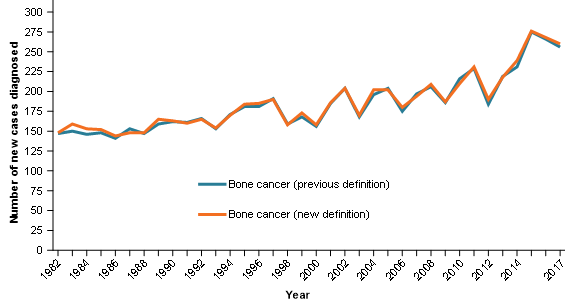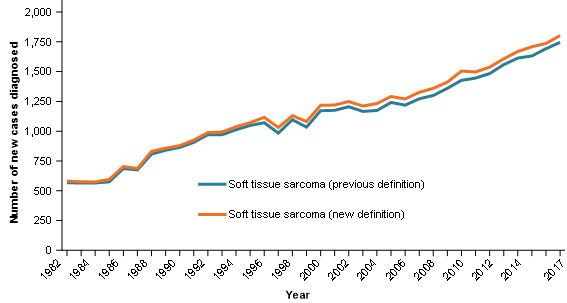Updating sarcoma reporting
Cancer data commentary no. 7
Cancer data in Australia (CdiA) now includes the group ‘all sarcomas combined’. Sarcomas are cancers that originate in bone, cartilage and the soft tissues of the body (for example, the ligaments, tendons, muscles, subcutaneous tissue and blood vessels). CdiA already includes data on soft tissue sarcoma and bone cancer and the combination of these produces ‘all sarcomas combined’.
Note that many kinds of cancer that originate outside bones can spread to the bones. However, CdiA only reports on cancers classified by their primary (original) site, not where they spread to (secondary sites). In the context of primary site, the terms “bone cancer” and “bone sarcoma” are equivalent, i.e. every primary cancer of the bone is a sarcoma.
Prior to the creation of this new cancer reporting category, a review was undertaken of the CdiA definitions of soft tissue sarcoma and bone cancer. This resulted in changes to both definitions. This commentary summarises the impact of these changes on the time series of incidence counts.
About the review process
The definitions of soft tissue sarcoma and bone cancer used in previous versions of CdiA were compared with the RARECAREnet project list of cancers. The RARECAREnet project involves partners all around Europe and aims at building an information network to provide comprehensive information on rare cancers to the community at large. The definitions used within the RARECAREnet project and potential changes to them were discussed with Australia’s cancer registries. It should be noted that the potential changes discussed with Australian cancer registries relate only to the cancer coding and not whether the cancer is rare.
Progress of the review
At the time of releasing CdiA, the review is not fully complete. It is possible that some further small changes will occur as work continues in this area. However, the current new definitions already offer a substantial improvement to existing reporting.
Impact of changes
The following sections highlight the impact of the changes to cancer incidence counts. The definitions themselves can be found in Appendix A.
Bone cancer
The impact of using the new definition is very small. Between 2008 and 2017 the new definition gives an average of 2 more cases per year than the old definition.
Figure 1: Cases of bone cancer, old and new definitions, persons, 1982–2017

Notes:
- 2017 counts include estimates for the Northern Territory and an estimate of late registrations for all other jurisdictions.
- 2016 counts include estimates of late registrations for the Northern Territory only.
Source: AIHW Australian Cancer Database 2017
Soft tissue sarcoma
The impact of using the new definition varies from year to year. Between 2008 and 2017 the new definition gives an average of around 58 more cases per year than the old definition.
Figure 2: Cases of soft tissue sarcoma, old and new definitions, persons, 1982–2017

Notes:
- 2017 counts include estimates for the Northern Territory and an estimate of late registrations for all other jurisdictions.
- 2016 counts include estimates of late registrations for the Northern Territory only.
Source: AIHW Australian Cancer Database 2017
Appendix A
The definitions are given in terms of ICD-O-3 topography and histology codes. The RARECAREnet list of cancers is available within the supplementary tables of the Incidence and survival of rare cancers in the US and Europe research paper.
Bone cancer
| Topograpy codes | Histology codes |
|---|---|
| C40, C41 | All except 9050–9055, 9140, 9590–9993 |
| Topography codes | Histology codes |
|---|---|
| C40, C41 | 8004 |
| C30, C32.3, C33, C34.0, C40, C41 | 8800–8806, 8810–8812, 8815, 8830, 8840, 8850–8855, 8890, 8891, 8894–8896, 8900–8902, 8910, 8912, |
| All | 9370, 9371, 9372 |
The new CdiA definition for bone cancer is the same as the RARECAREnet definition but also includes codes shown in Table 3.
| Topography codes | Histology codes |
|---|---|
| C40, C41 | 8000, 8002, 8003 |
| C30, C32.3, C33, C34.0, C40, C41 | 9261 |
Soft tissue sarcoma
| Topography codes | Histology codes |
|---|---|
| All except C40, C41 | 8800–8936, 8990–8992, 9040–9045, 9120–9262, 9540–9582 |
| Topography codes | Histology codes |
|---|---|
| C49 | 8004 |
| All except C30, C32.3, C33, C34.0, C40, C41 | 8710, 8711, 8714, 8800–8806, 8810–8815, 8825, 8830, 8832, 8833, 8840, 8842, 8850–8855, 8857, 8858, 8890, 8891, 8894–8896, 8900–8902, 8910, 8912, 8920, 8921, 8930, 8931, 8933–8935, 8959, 8963, 8964, 8990, 8991, 9020, 9040–9044, 9120, 9124, 9130, 9133, 9137, 9150, 9170, 9180–9183, 9185–9187, 9192–9195, 9220, 9231, 9240, 9251, 9252, 9260, 9364, 9365, 9540, 9542, 9560, 9561, 9571, 9580, 9581 |
| All except C30, C32.3, C33, C34.0, C40, C41 and C07, C08, C44, C60, C63.2 | 8940 |
| All except C30, C32.3, C33, C34.0, C40, C41 and C56, C71, C72 | 9473 |
| All except C30, C32.3, C33, C34.0, C40, C41 and C71, C72 | 9503 |
The new CdiA definition for soft tissue sarcoma is the same as the RARECAREnet definition but also includes codes shown in Table 6.
| Topography codes | Histology codes |
|---|---|
| All | 8936, 9140 |
| All except C30, C32.3, C33, C34.0, C40, C41 | 9045 |


